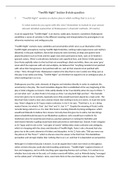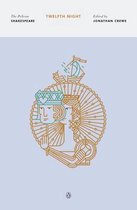“Twelfth Night” Section B-style question
7. ‘“Twelfth Night” remains an elusive play in which nothing that is so is so.’
To what extent do you agree with this view? Remember to include in your answer
relevant detailed exploration of Shakespeare’s dramatic methods. (25 marks)
It can be argued that “Twelfth Night” is an elusive, subtle play; however, sometimes Shakespeare
establishes a sense of certainty in the different meanings and interpretations he promulgates in an
otherwise mysterious and ambiguous play.
“Twelfth Night” contains many subtleties and uncertainties which serve as an illustration of the
Twelfth Night atmosphere. During Twelfth Night festivities, nothing makes logical sense and reality is
distorted. In the past traditions, hierarchal structures were inverted, as kings and queens were
played by jesters such as Feste and the upper class were portrayed as fools, such as Sir Andrew’s
ignorant nature, Olivia’s contradictory behaviour and superficial love, and Orsino’s fickle persona.
Even Feste explicitly refers to the fact that not everything is black and white; there are some ‘grey’
areas which he expresses with wit and wordplay. He believes that “anything mended is but patched
with virtue that transgresses is but patched with sin, and sin that amends is but patched with
virtue.” Here, through Feste, Shakespeare explores the idea that no one is solely one thing, just as
this play is not solely one thing. “Twelfth Night” can therefore be argued to be an ambiguous play, in
which nothing that is so is so.
Shakespeare uses the comic elements of disguise and mistaken identity in order to emphasis the
uncertainty in the play. The most immediate disguise that is established at the very beginning of the
play is Viola’s disguise as Cesario. Viola subtly alludes to her true identity when she says to Olivia: “I
am not what I am”, as does Feste in his songs as Viola “can sing both high and low”. The dramatic
irony here gives rise to comedy, especially since Viola would have been played by a male actor. The
idea that Viola is both a man and a woman shows that nothing is truly as it seems. In much the same
way, Feste’s disguise as Sir Topaz creates confusion. In Act 4, he says: “That that is, is: so I, being
master Parson, for what is ‘that’, but ‘that’ and ‘is’, but ‘is’?” Despite the meaning of Feste’s witty
remarks being unclear to us, it is clear that Feste is mocking Malvolio by being ambiguous, which
would lead Malvolio to believe his is insane. Not only does this give rise to satire, but also brings
about schadenfreude because to an Elizabethan audience, (who would have revelled in his
misfortune since he would be perceived as a puritan adamant on ruining the festivities and
merriment) Malvolio’s gulling would have been perceived as well-deserved. Overall, Feste’s disguise
as Sir Topaz and his role as the “corrupter of words” deliberately create confusion and ambiguity,
which is in keeping with the chaos and disorder of Twelfth Night. Feste’s role a licensed fool also
gives rise to the comic elements of trickery and deception. In Act 2, Feste asks: “Did you never see
the picture of ‘We Three’?” which is obscure since the viewer is the third fool. This destabilises
perception and strongly implies that ‘nothing that is so is so’ and that it is dependent on perspective.
Although it is evident that play is elusive, it can be argued that it does not remain so throughout;
rather at times the play could also hold troubling undertones. “Twelfth Night” explores themes of
love and vengeance, and so while touching upon opposing themes such as these, it is unclear to us
whether love truly wins in the end, or if sinister events will follow, such as Malvolio being “revenged
on the whole pack” of tricksters. Here, even Feste hints at the uncertainty when he says: “And thus





